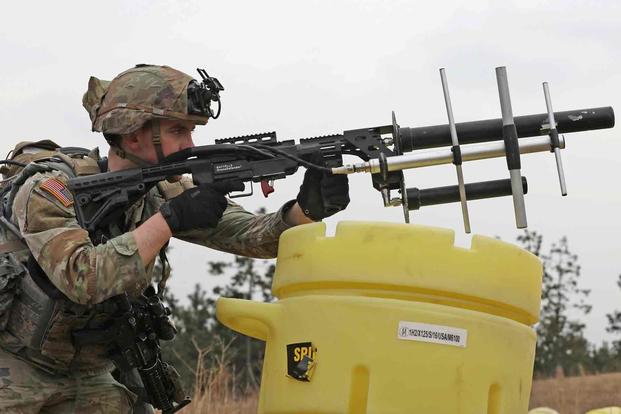Funerals began Tuesday for the three U.S. service members who were killed -- among scores of others injured -- last month following a drone attack in Jordan. But two weeks after the attack on the remote base, the Pentagon has not outlined any new moves to bolster defenses against the drone threat in the region.
Defense officials and experts have spent the last decade warning against the oncoming threats of drones in future warfare, even as the U.S. has enjoyed virtually unchallenged air superiority since the Korean War. Those warnings became stark reality when the drone launched by Iran-backed militants struck trailers where troops slept on Jan. 28.
In October, the Pentagon pledged more air defense systems to the Middle East, but much of the military's own doctrine still has few answers for how troops are supposed to counter drones. For example, the Army's 596-page doctrine that covers much of its ground warfare tactics mentions drones only once and that infantry are simply supposed to shoot machine guns at them. That doctrine was last updated Jan. 11.
"It's a simple misunderstanding of how drones have changed and how wars are fought," Rep. Ruben Gallego, D-Ariz., told Military.com in an interview.
"There is no such thing as a safe [area of operation] anymore," Gallego, a Marine Corps veteran and House Armed Services Committee member, added. "We've known about the problem for a while. What have we done? We haven't changed any doctrine or any training or any type in any real way."
Pentagon officials have long stressed that they feel the total defense assets in the Middle East are sufficient, even as violence has flared following the start of the Israel-Hamas War in Gaza.
On Jan. 30, just days after the deadly attack in Jordan, Brig. Gen. Patrick Ryder, the Pentagon's top spokesman, told reporters that "Central Command is going to take and is taking necessary steps to ensure that our forces are protected." Part of that plan includes the Army fast-tracking a $75 million purchase of 600 Coyote 2C Interceptors, a missile system that can shoot down drones -- though it's unclear when those systems will actually be deployed.
The purchase of Coyote interceptors also raises questions about the cost effectiveness and sustainability of using high-tech missiles against the relatively cheap and plentiful drones that are flown by Iranian-backed militias in the Middle East.
"We've got to figure out a better way to do this ... a more cost-effective way than shooting down $40,000-$50,000 unmanned aerial vehicles with millions of dollars worth of missiles," Lt. Gen. Karsten Heckl, the Marine Corps' deputy commandant for combat development and integration, said Tuesday.
Heckl, who was speaking at West 2024, a naval conference in San Diego, said that the Marines are "working very hard to get on the right side of the cost curve."
The Navy has been fairly successful at combating drones at sea. The service's top officer, Adm. Lisa Franchetti, told the crowd at West that ships have now downed more than 70 drones. Navy officials have said these downings were done with missiles as well as jets from the aircraft carrier USS Dwight D. Eisenhower and 5-inch guns on destroyers.
However, Heckl raised the question of how long this defense can be sustained.
"Right now, we're just dealing with Houthis. What happens if something got triggered? Now, we got a real problem," he said.
The Pentagon announced a surge in air defenses just days after attacks on bases in Iraq and Syria began in October after the start of the Gaza war. On Oct. 24, Ryder said additional Patriot missile batteries and Terminal High Altitude Area Defense, or THAAD, batteries were deployed to the area from Fort Bliss in Texas, Fort Liberty in North Carolina, and Fort Sill in Oklahoma.
Despite those earlier moves to shore up defenses, it is still unclear how a drone piloted by Iran proxies was able to circumvent air defenses at Tower 22, where the three Army reservists were killed and at least 40 additional soldiers, all with the Army National Guard, were injured. Another 11 airmen from the Air Force Reserve and National Guard were also wounded.
U.S. forces in the Middle East have been attacked more than 160 times since October, including with drones. "There have been approximately 186 casualties in Iraq, Syria and Jordan since Oct. 18. Of those 186 casualties, over 130 are currently assessed as having traumatic brain injury," the Pentagon said Monday.
Much of the U.S. presence in the Middle East and Africa is made up of about 20,000 National Guardsmen who are deployed on average at any given time, with the Army side of the service component making up the lion's share of ground troops.
The Army's training on countering drones is still in its infancy, introduced to basic training only last summer and mostly about evading detection -- not destroying.
Last year, the service outfitted two of its premier divisions -- the 82nd Airborne and 1st Cavalry -- with weapons for soldiers to counter drones, though that leaves much of the service underequipped and undertrained. The Army did not provide an interview on counter-drone training ahead of publication.
In January, Military.com reported that some Marine units rotating to the Pacific, who would serve as front-line troops in a situation in which relations with China deteriorated into conflict, do not have counter-drone capabilities and often rely on partner forces such as the Philippine and Indonesian forces. The service plans to expand its capabilities within the next decade.
"None of us will ever be happy until we have a 100% system that's going to work and protect everybody and everything," Gen. Daniel Hokanson, chief of the National Guard Bureau, told reporters at a press conference last week.
Related: Army Still Weighing Combat Awards for Soldiers Hit by Deadly Drone Attack at Jordan Base














